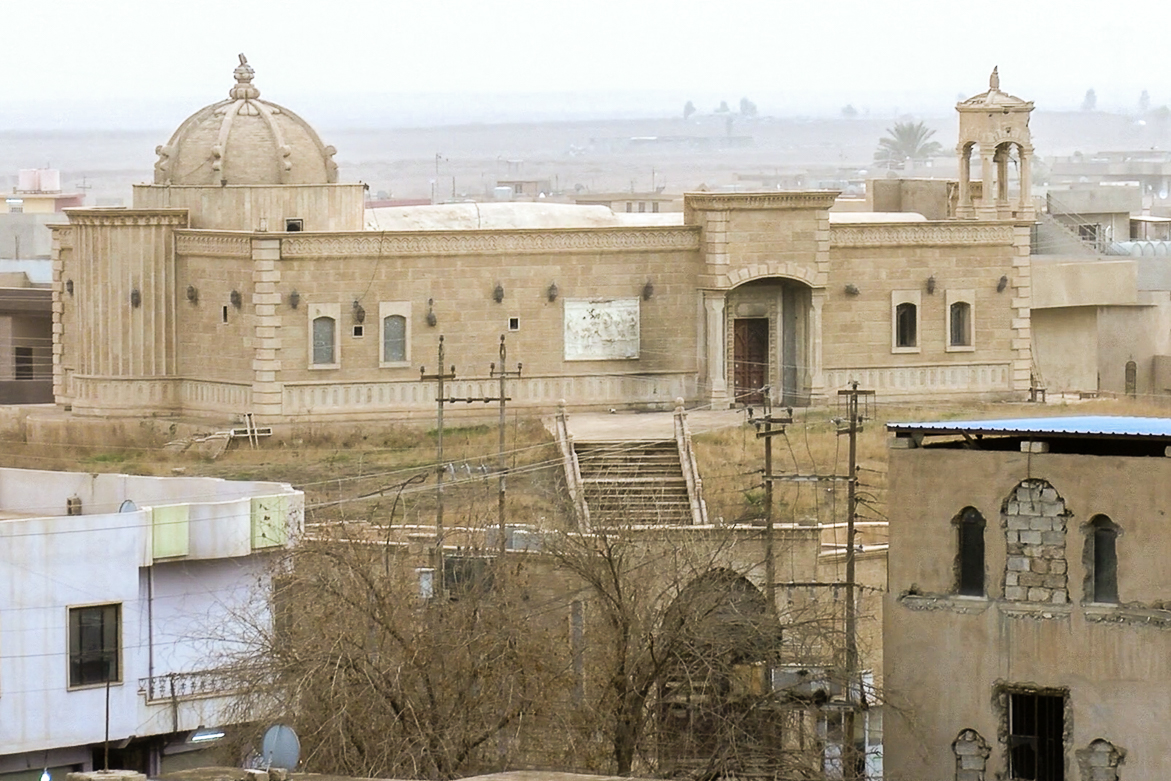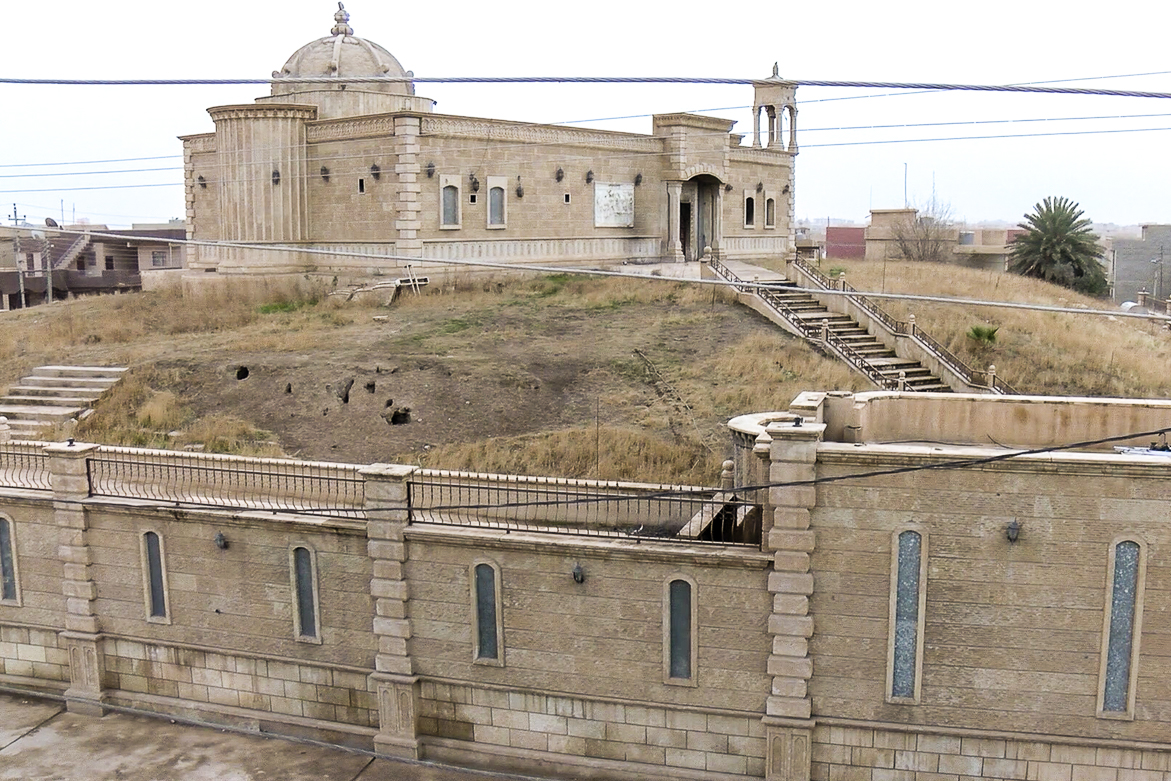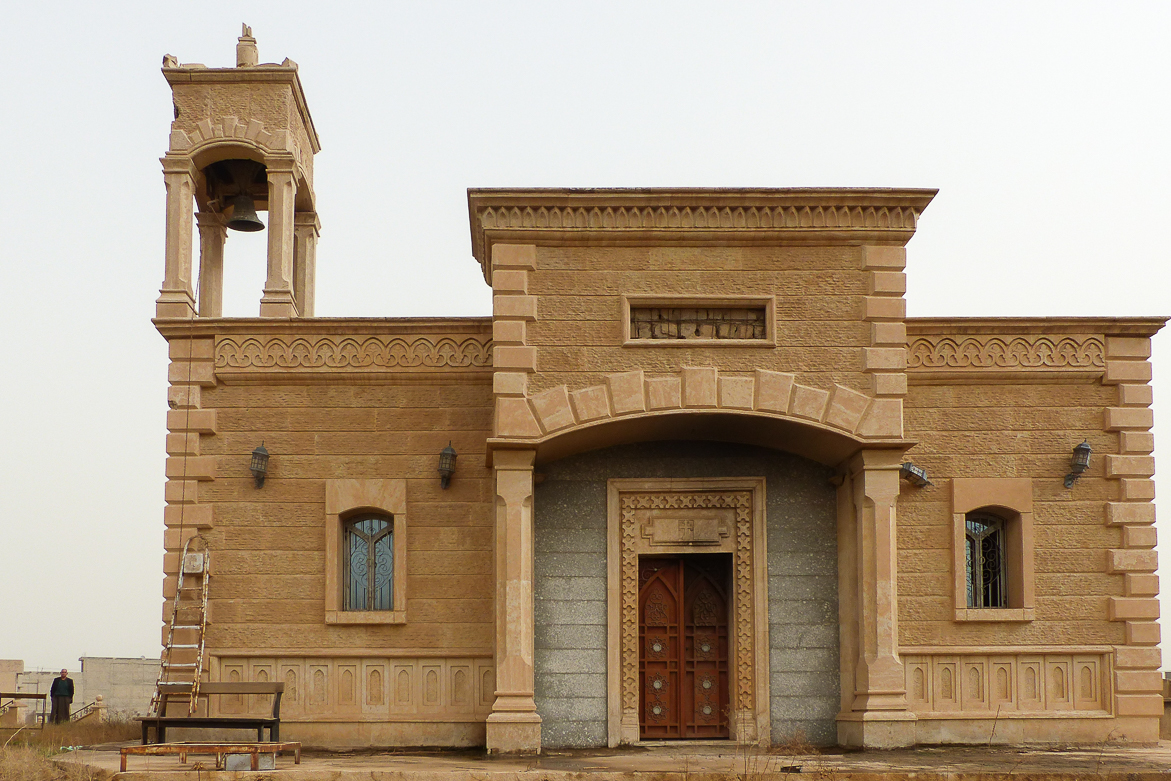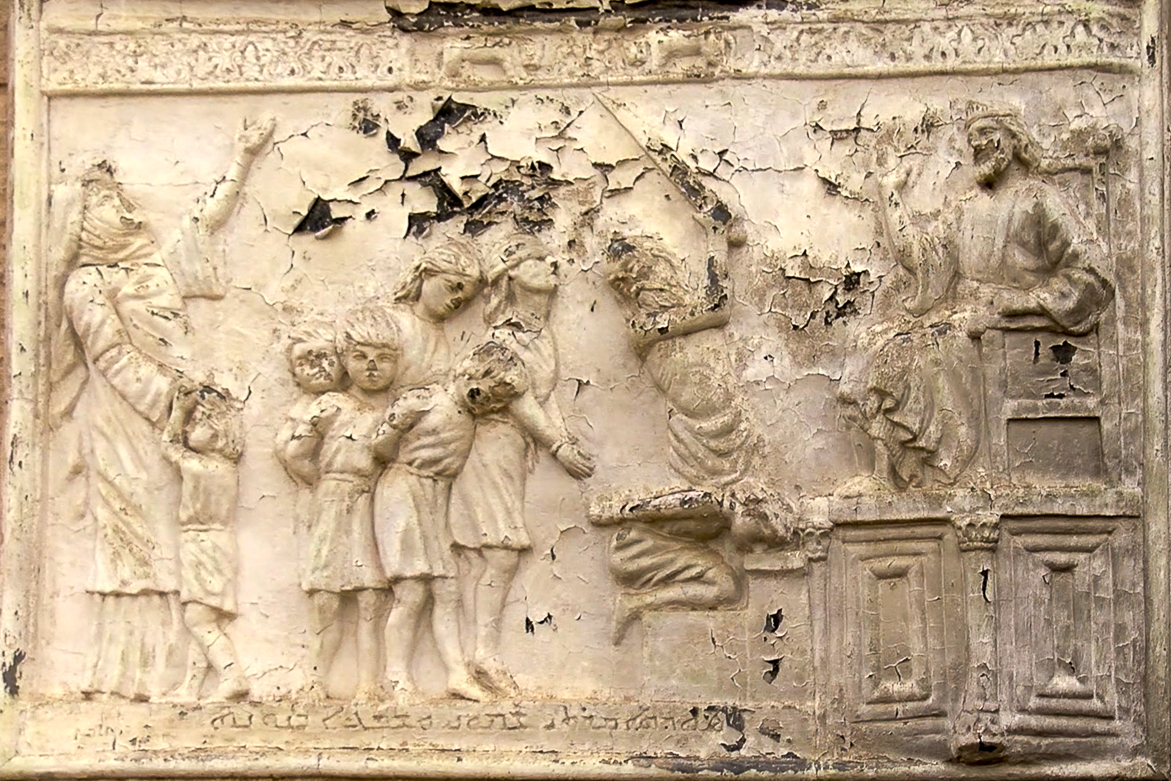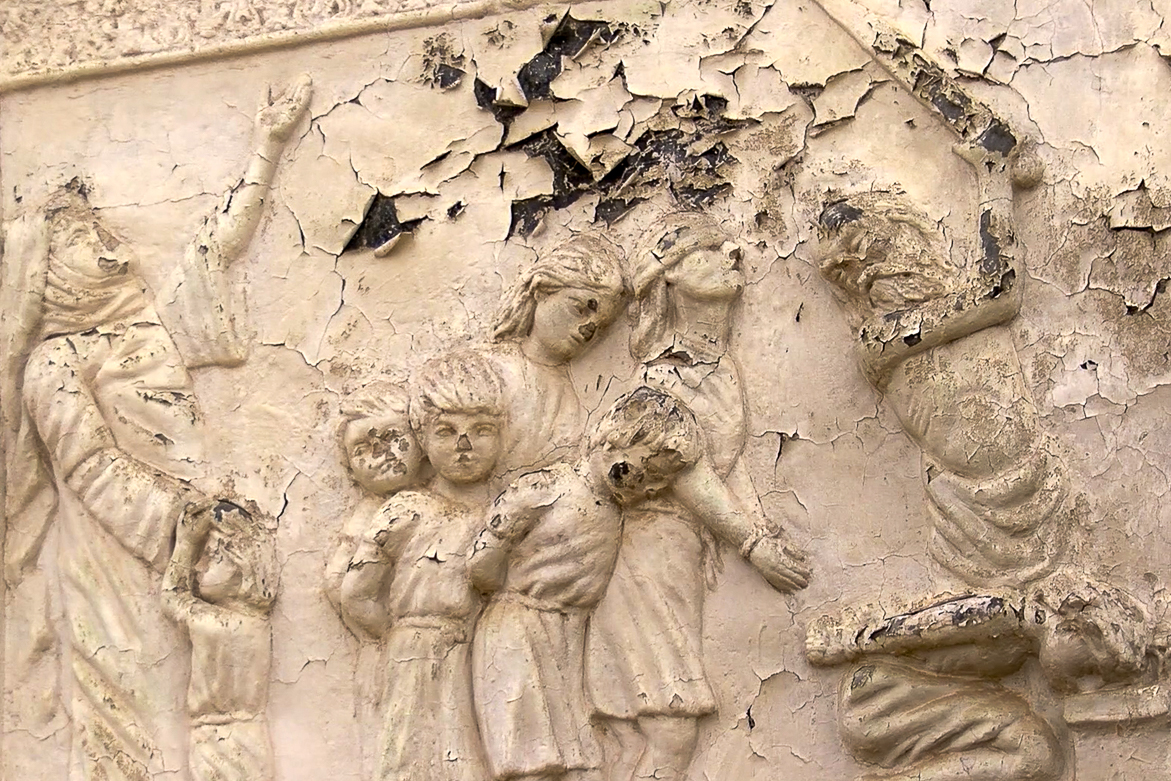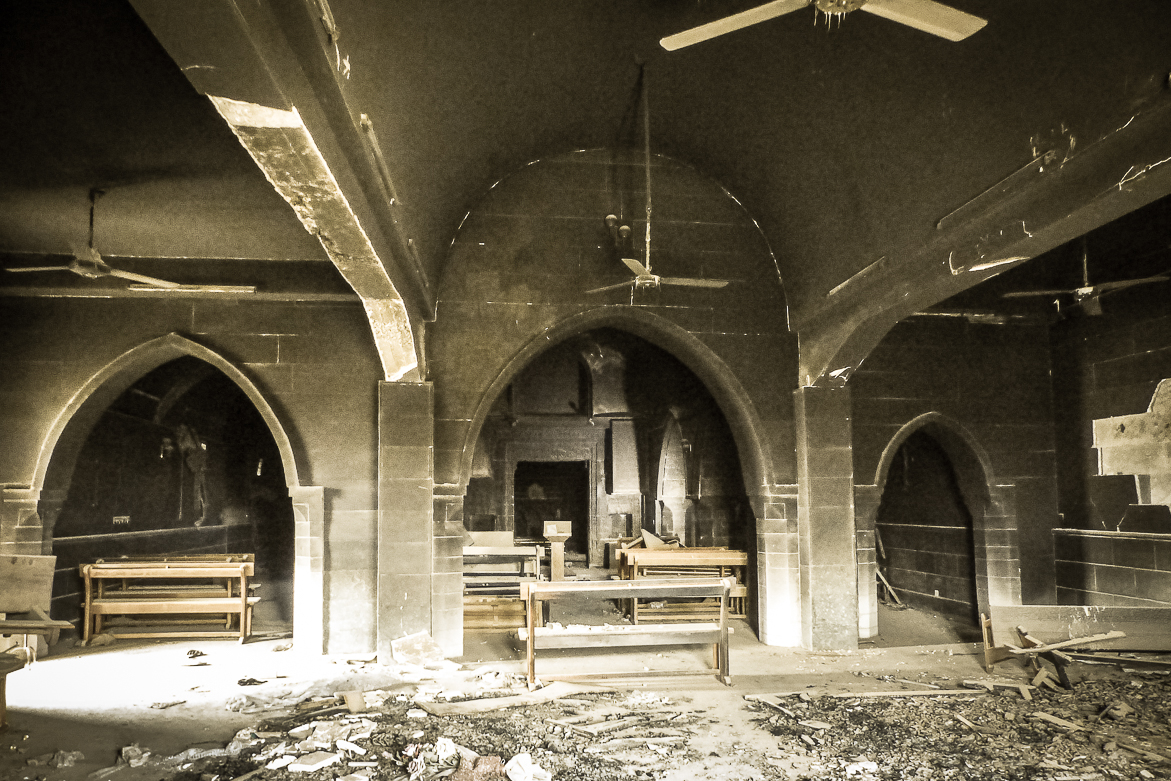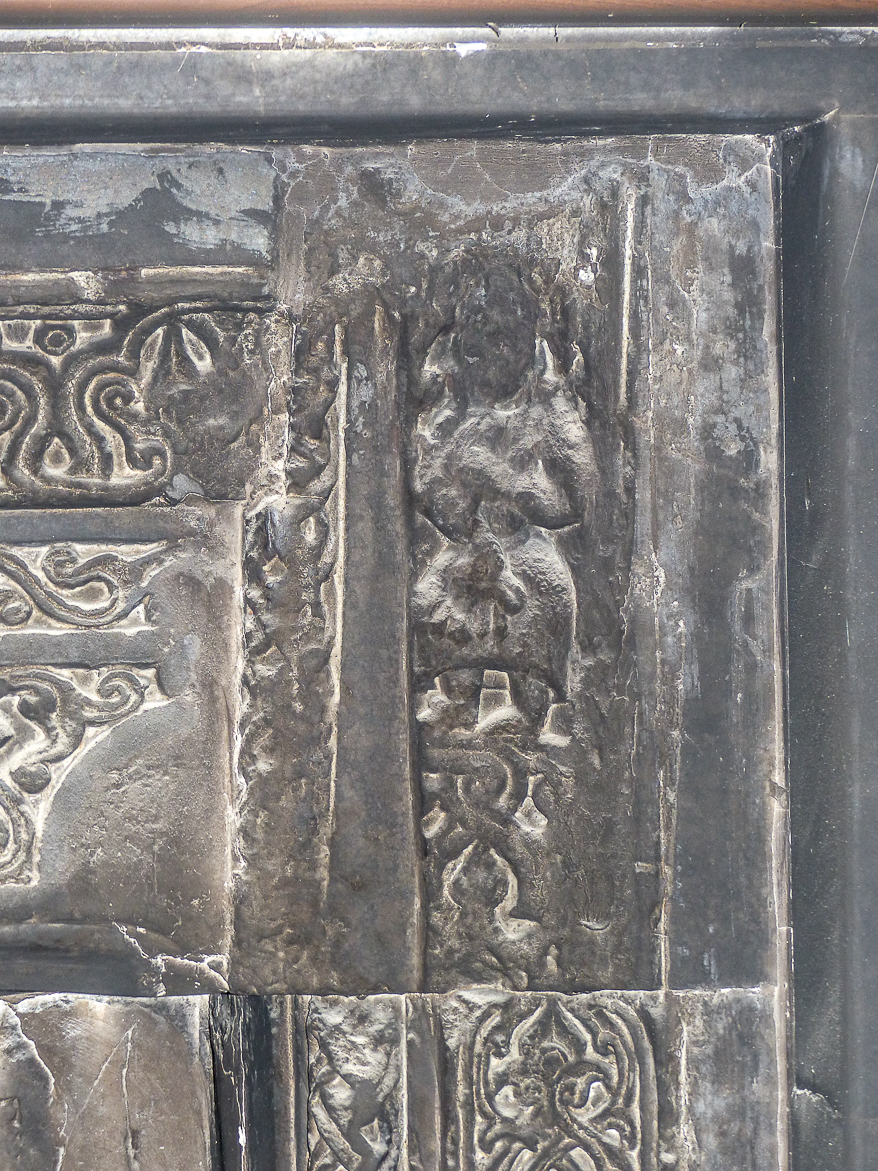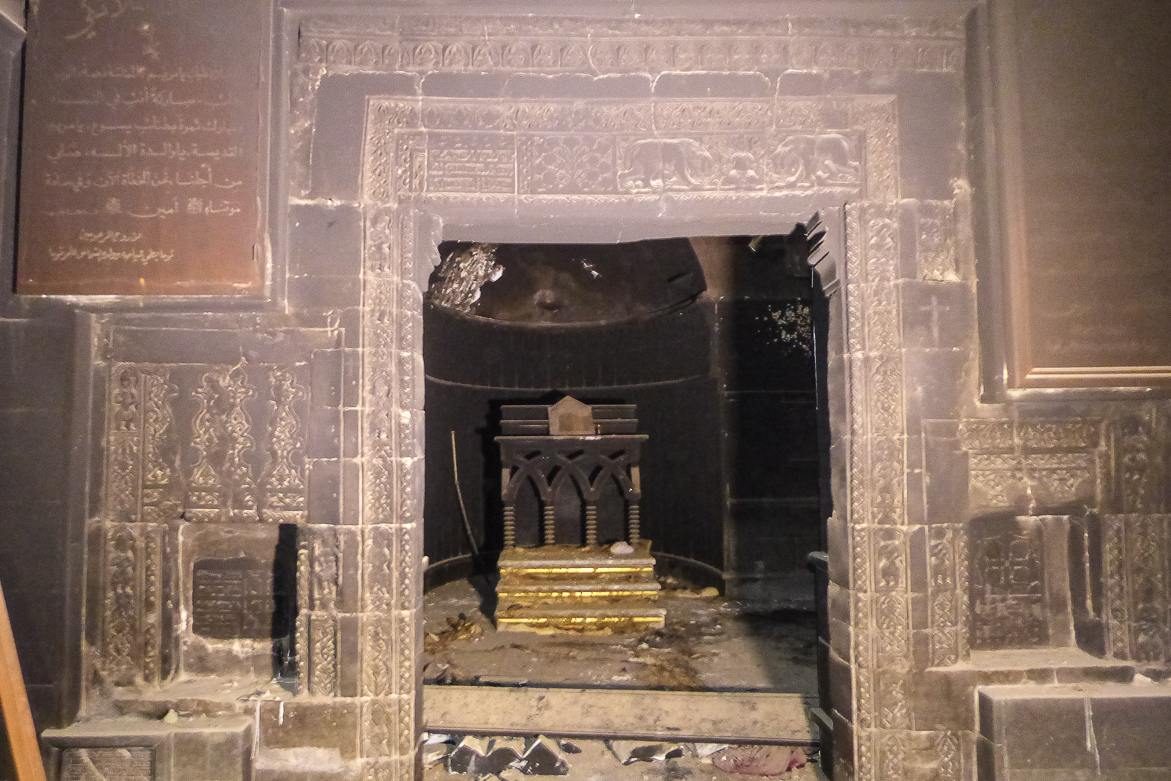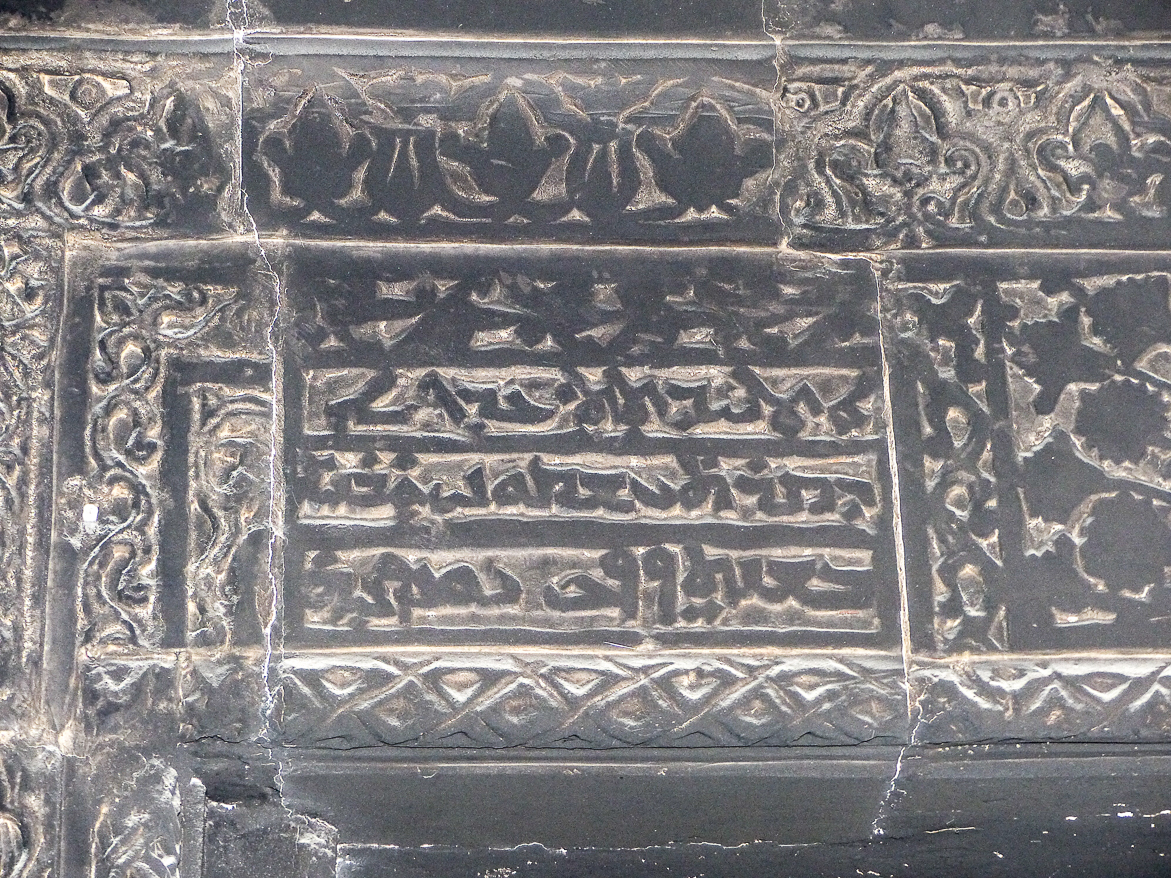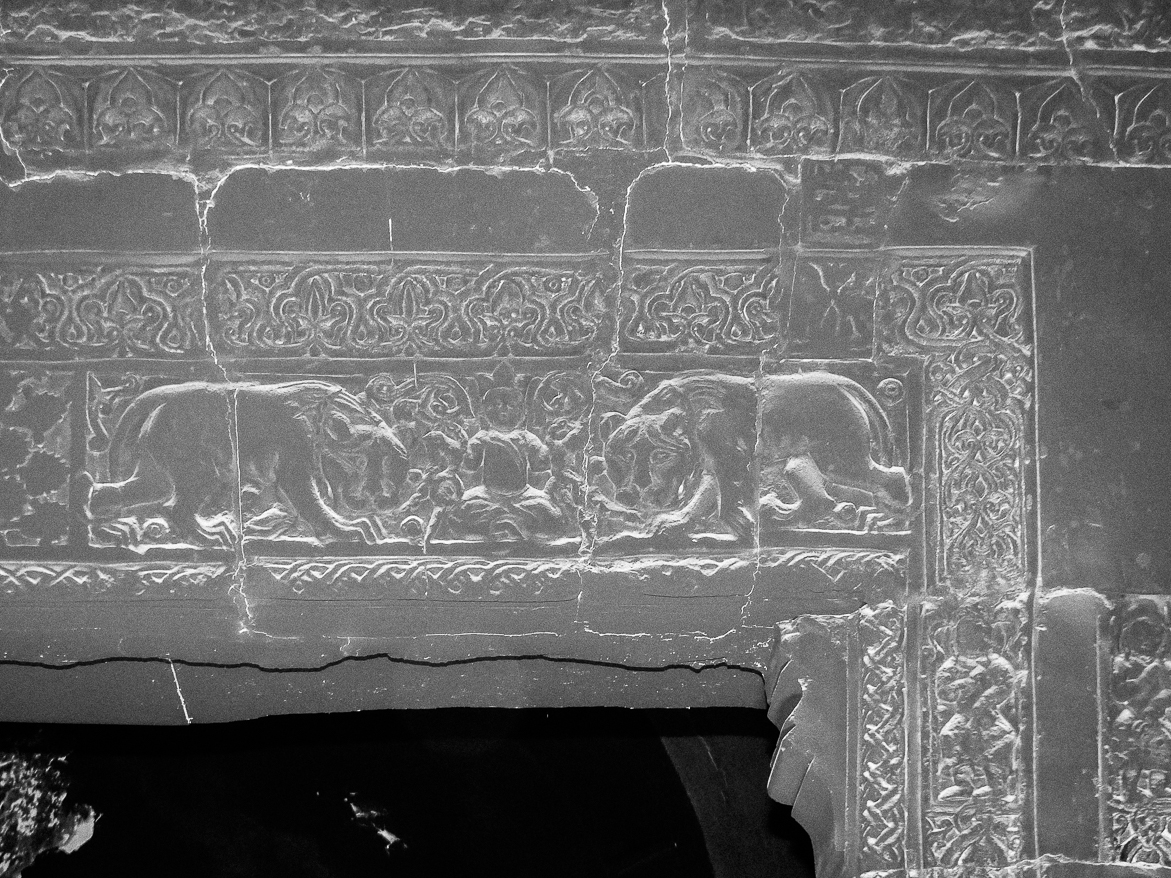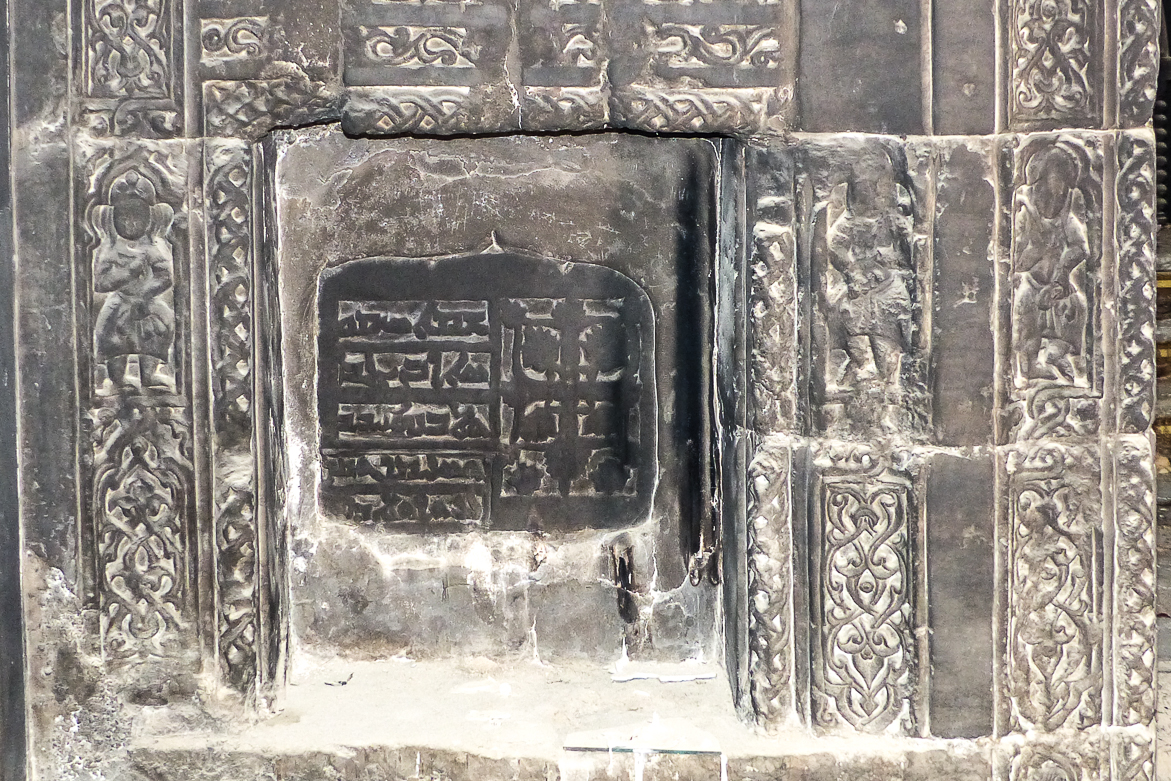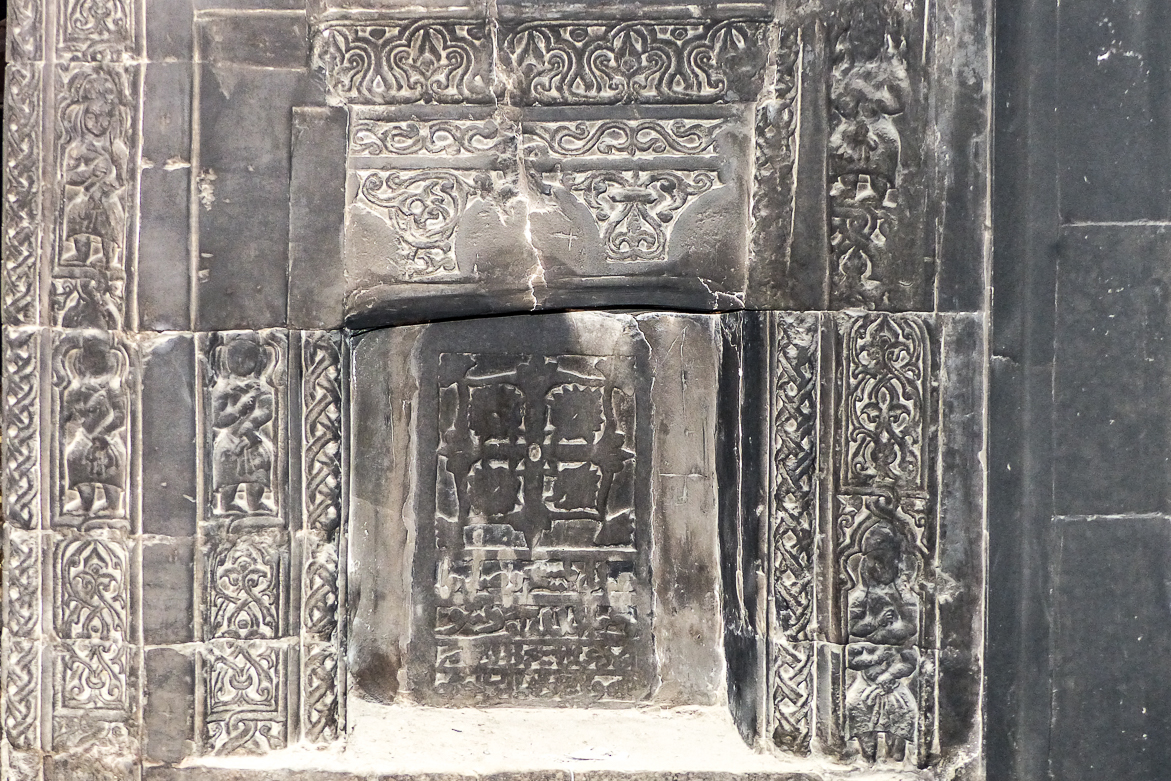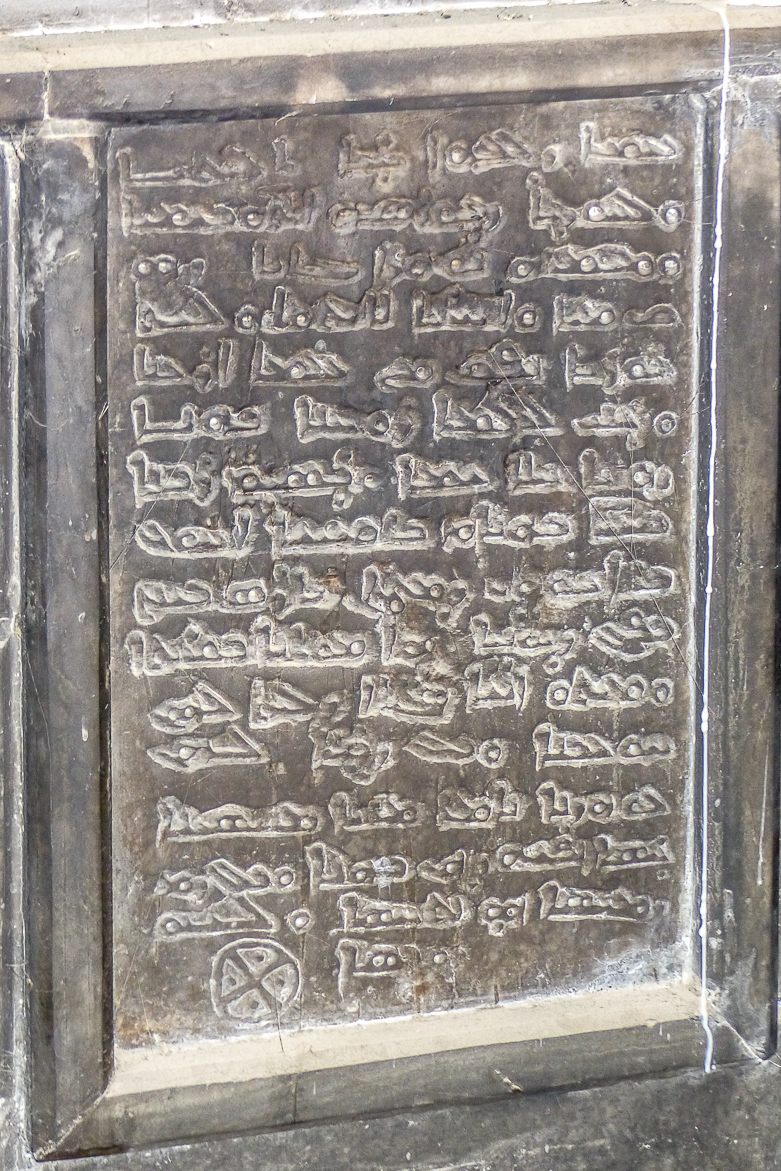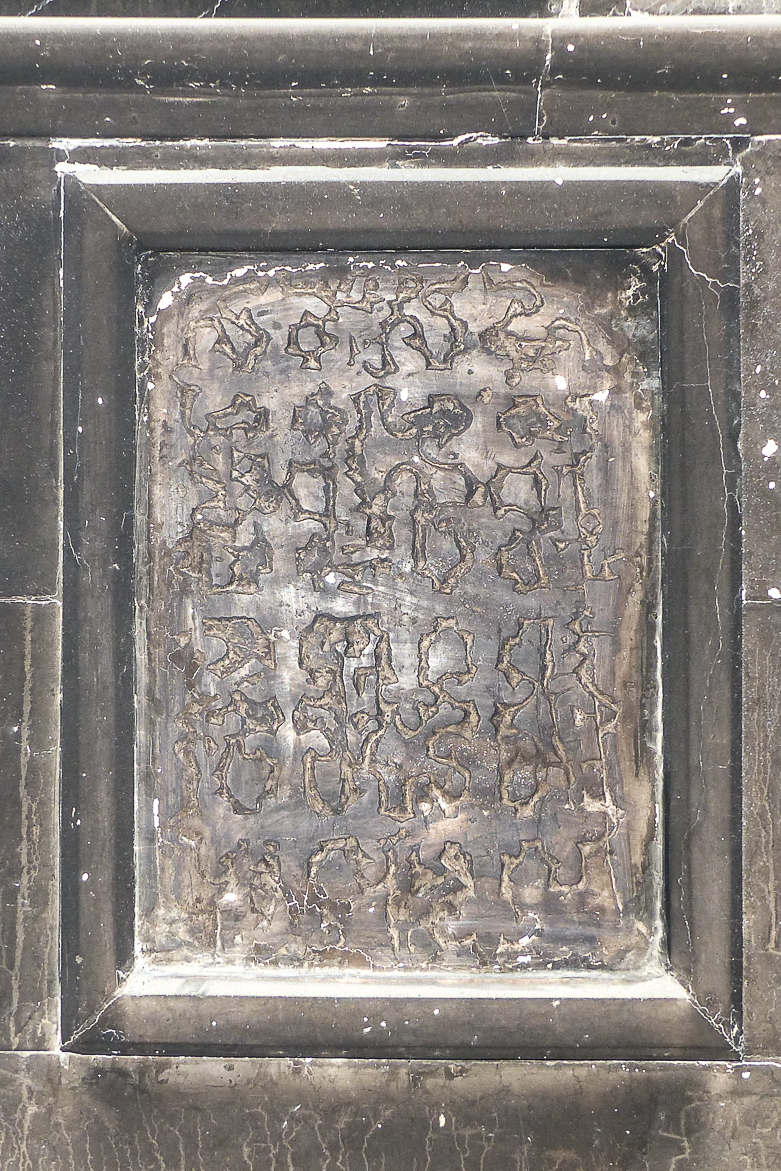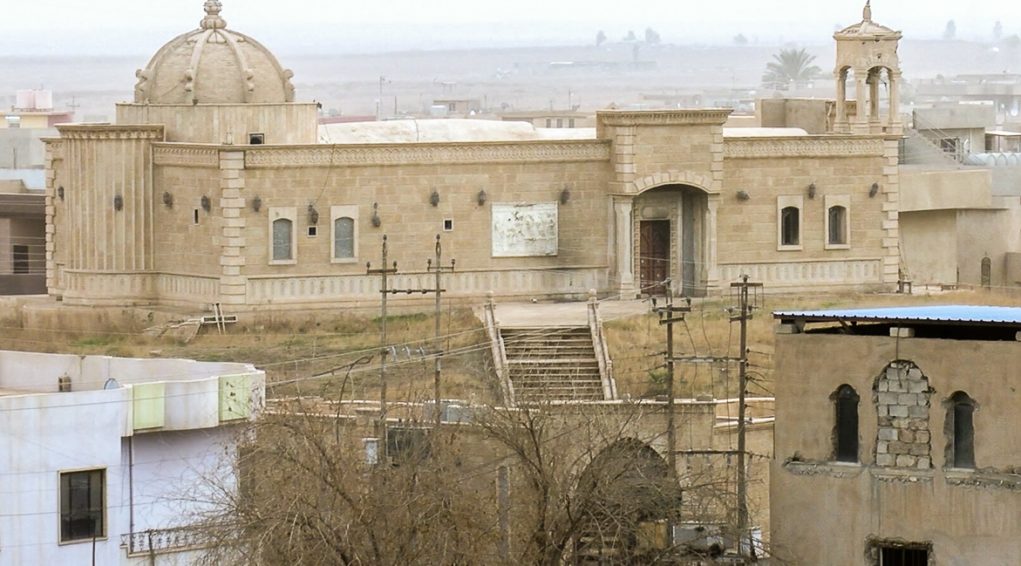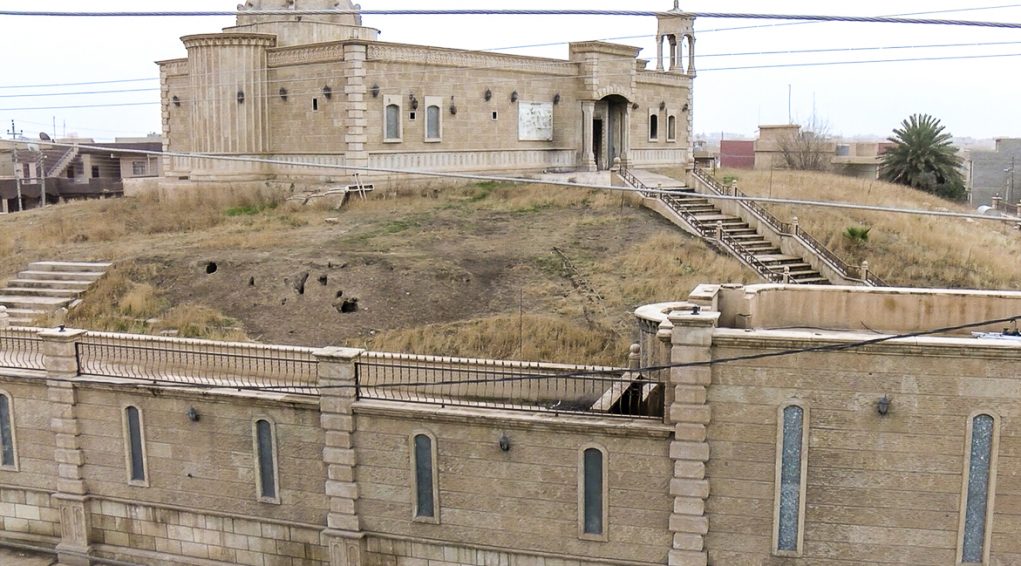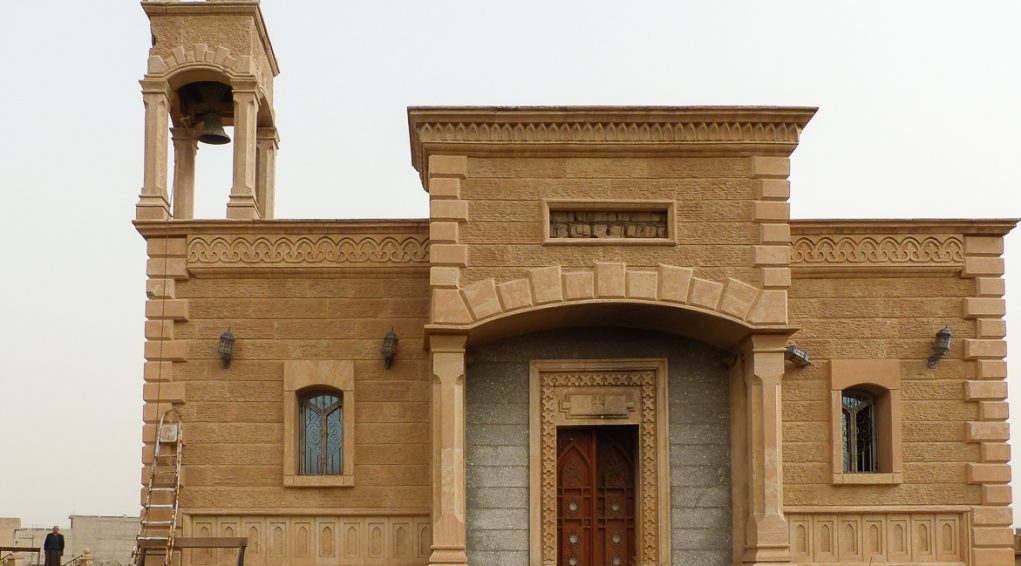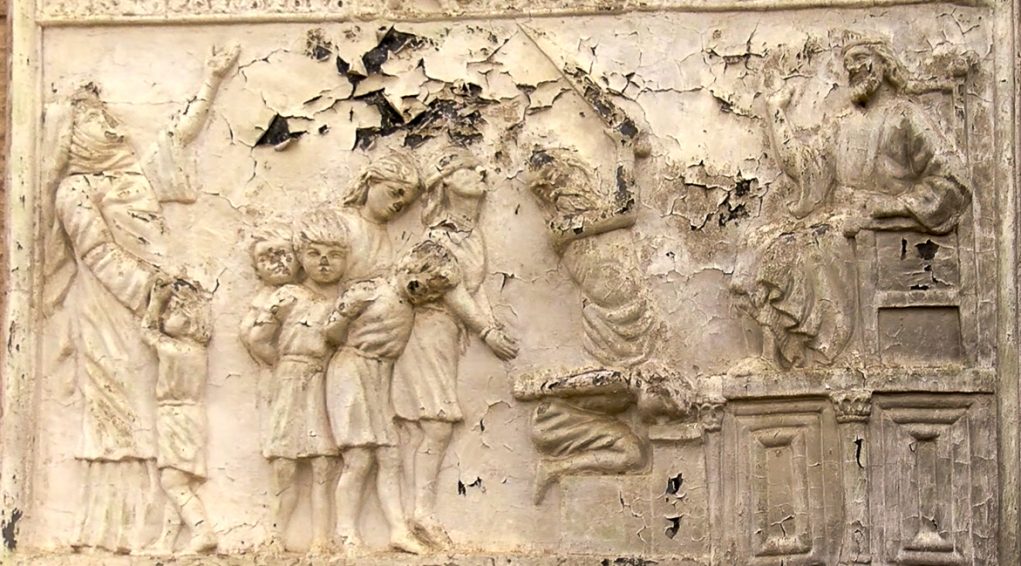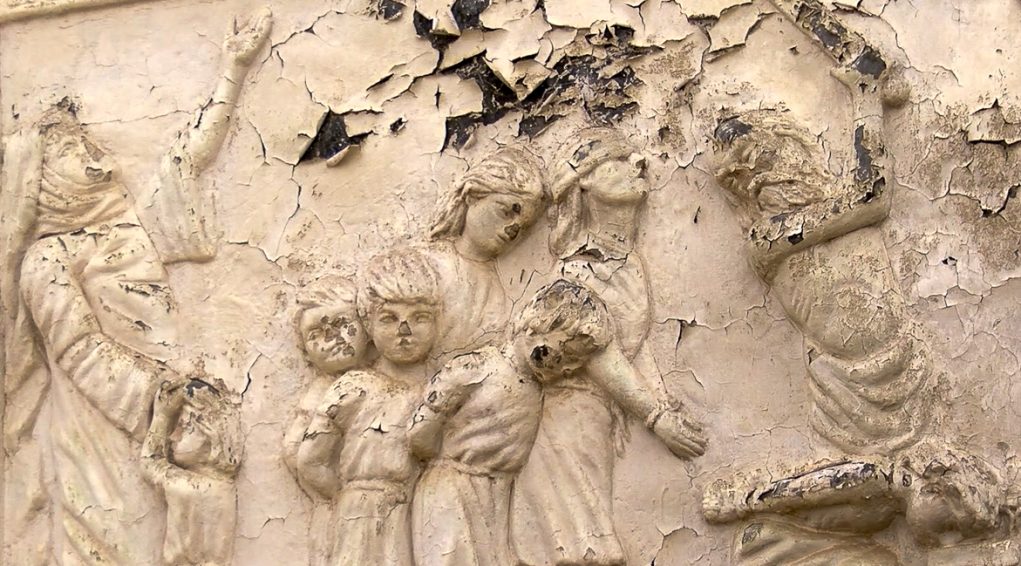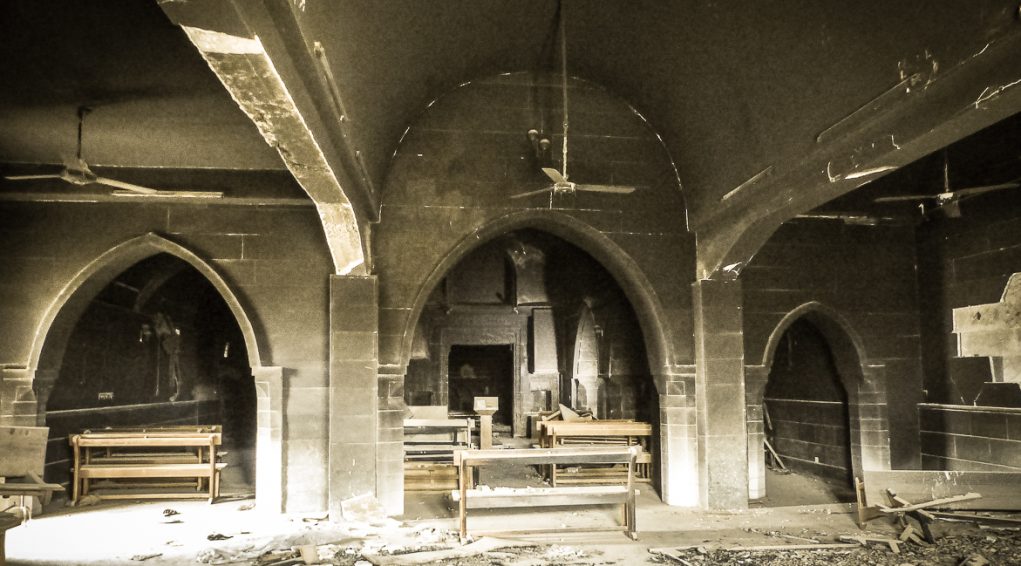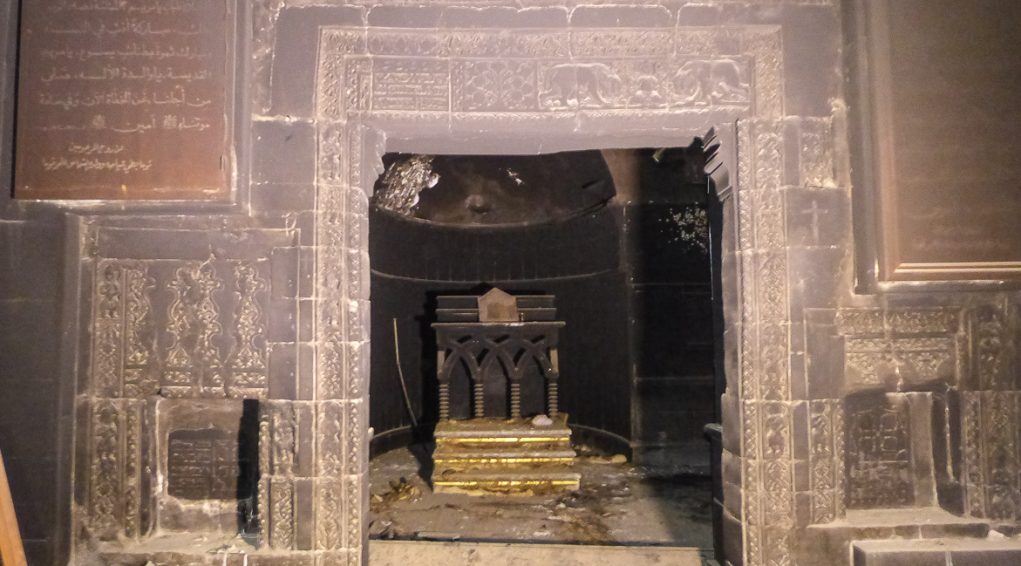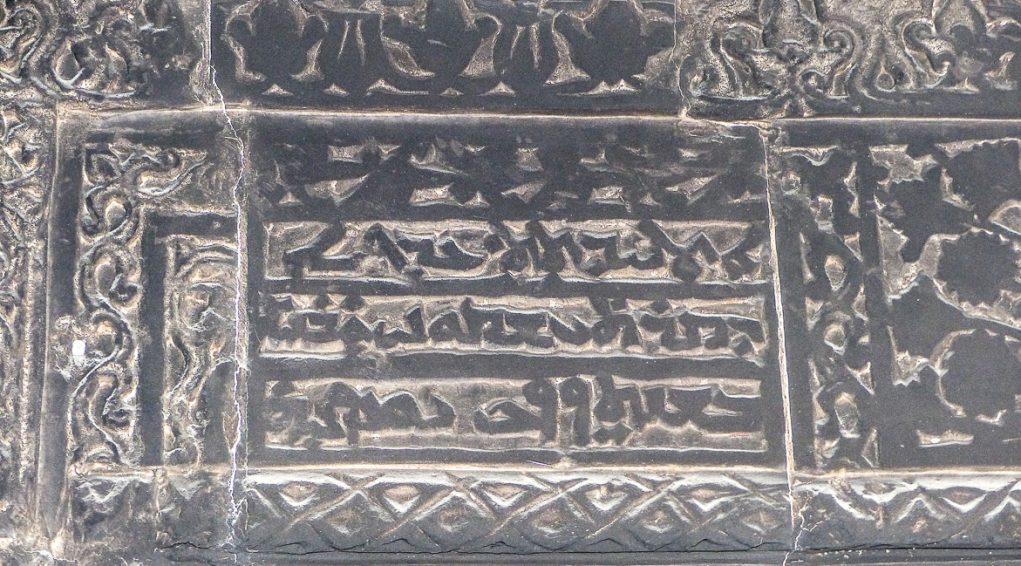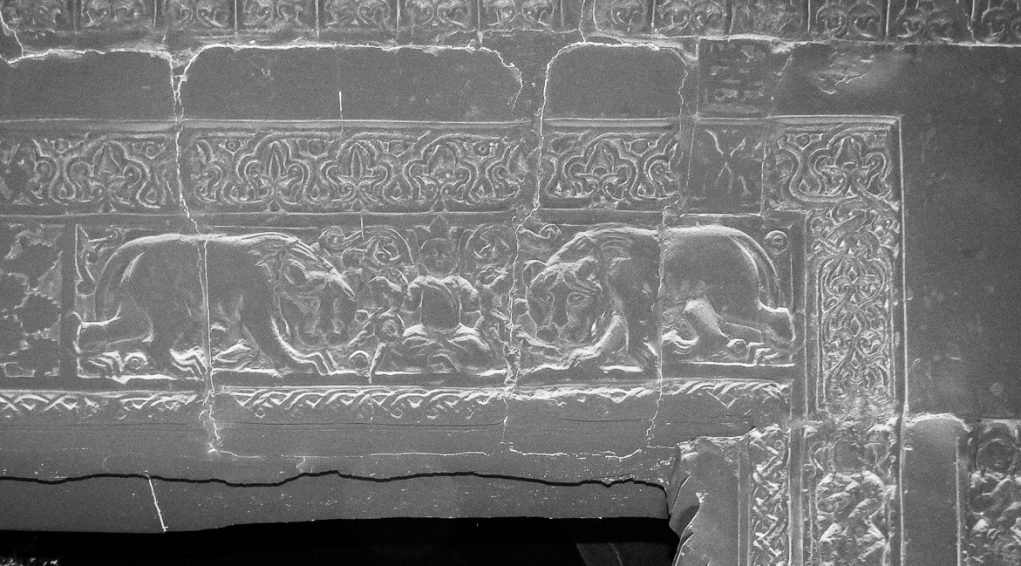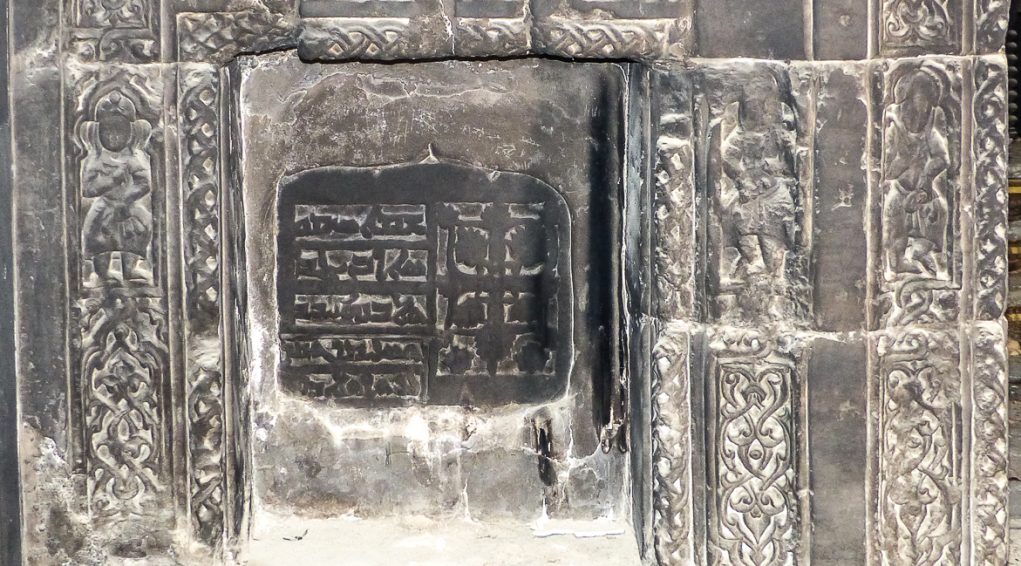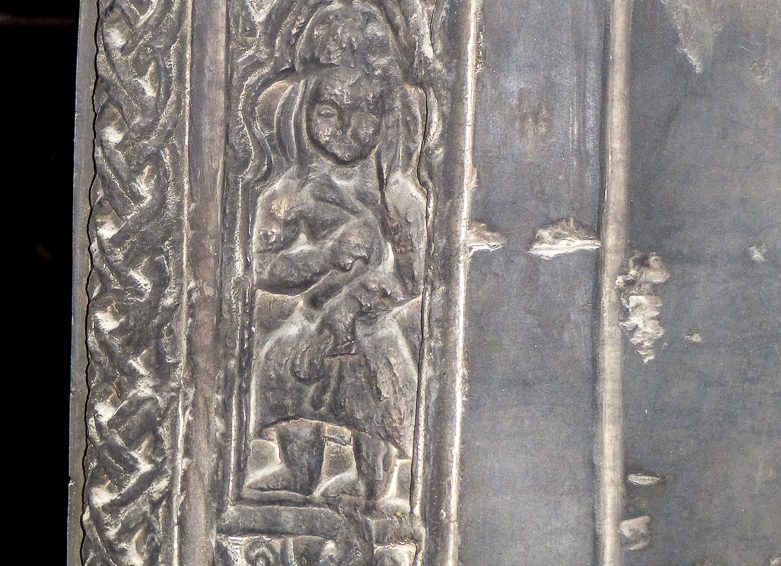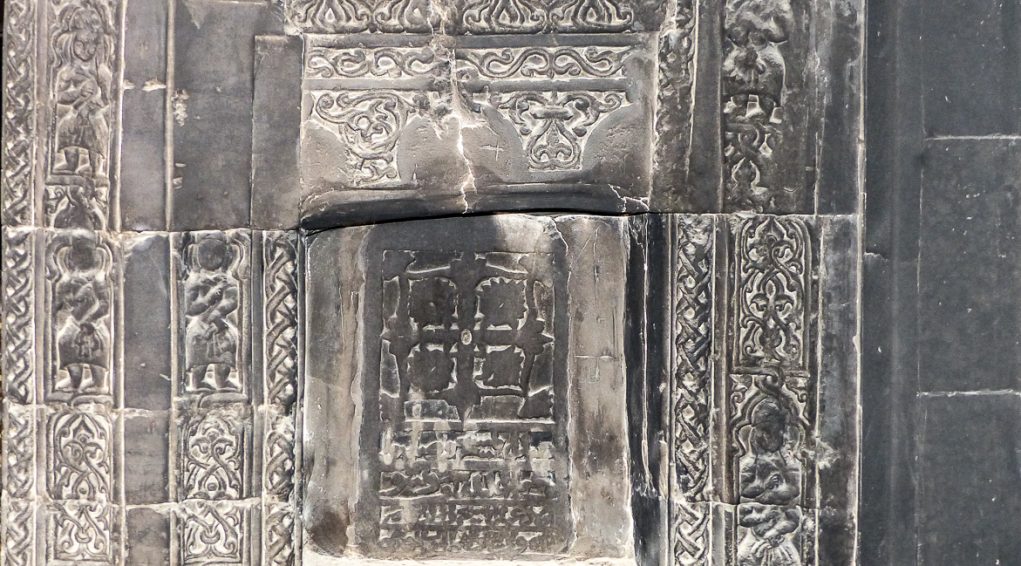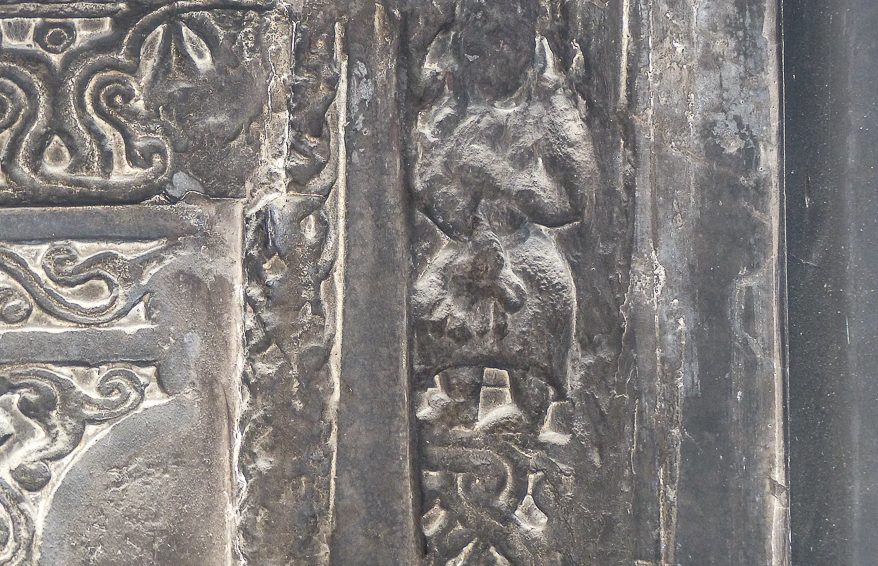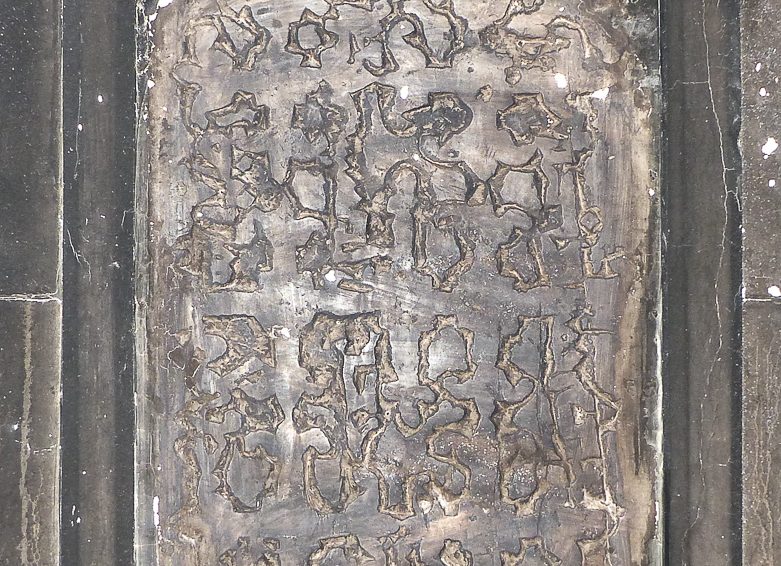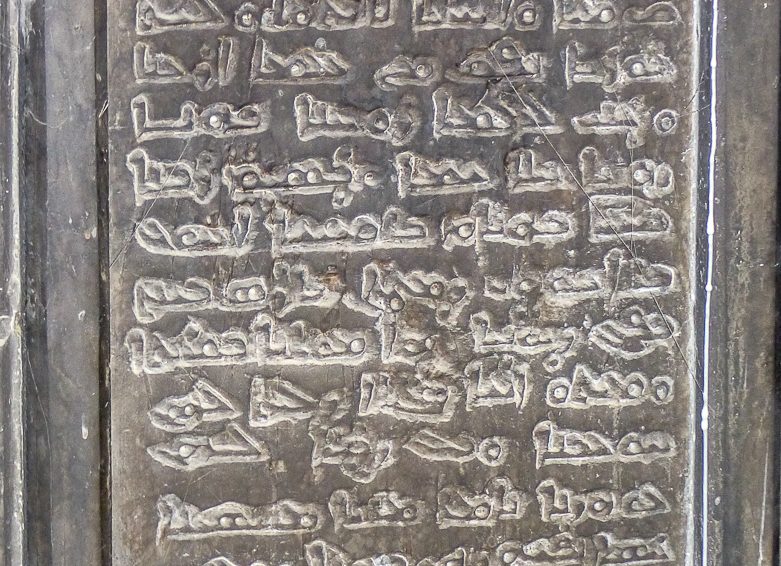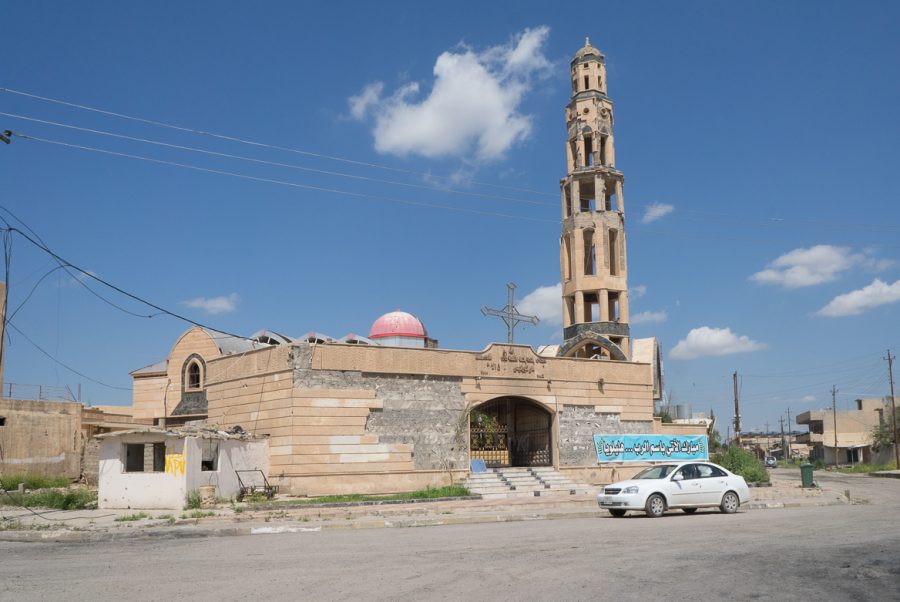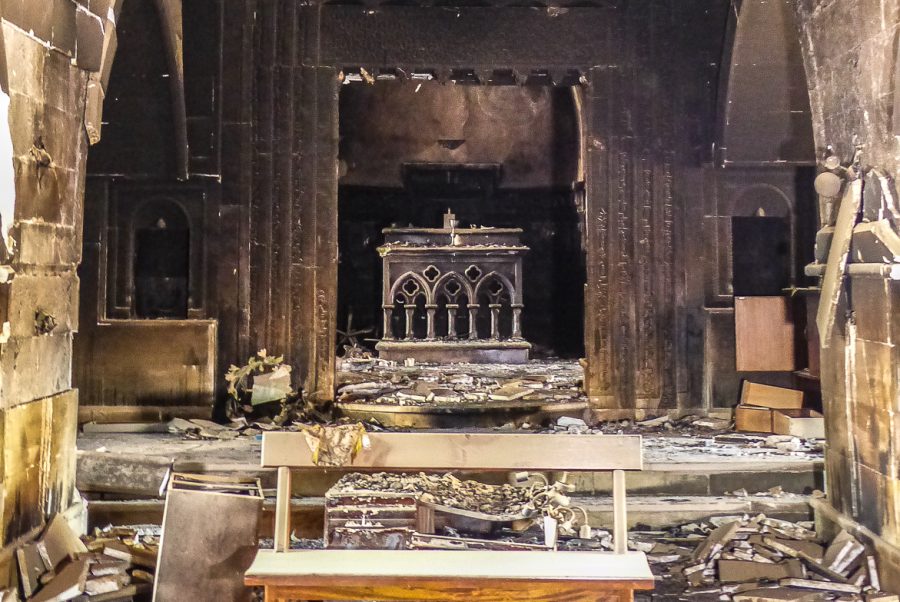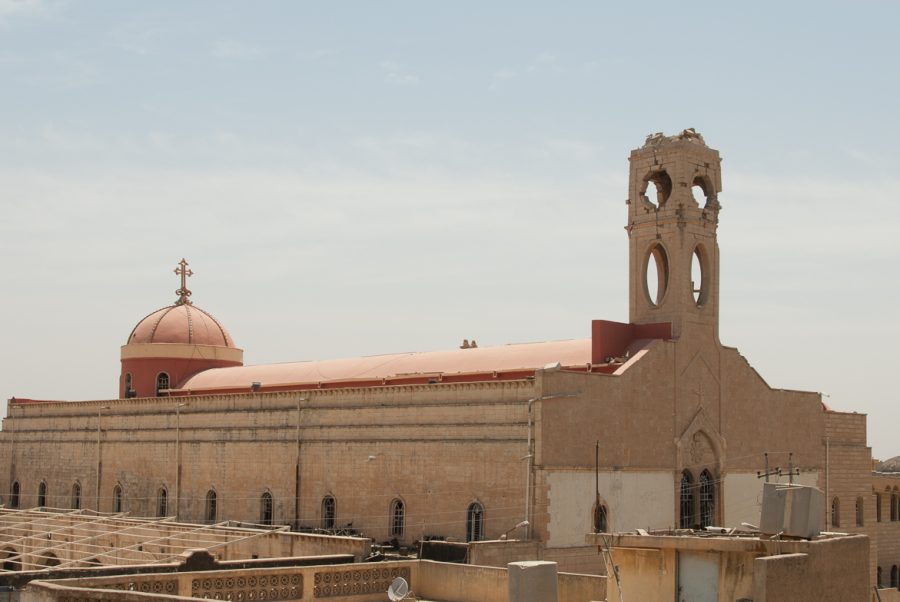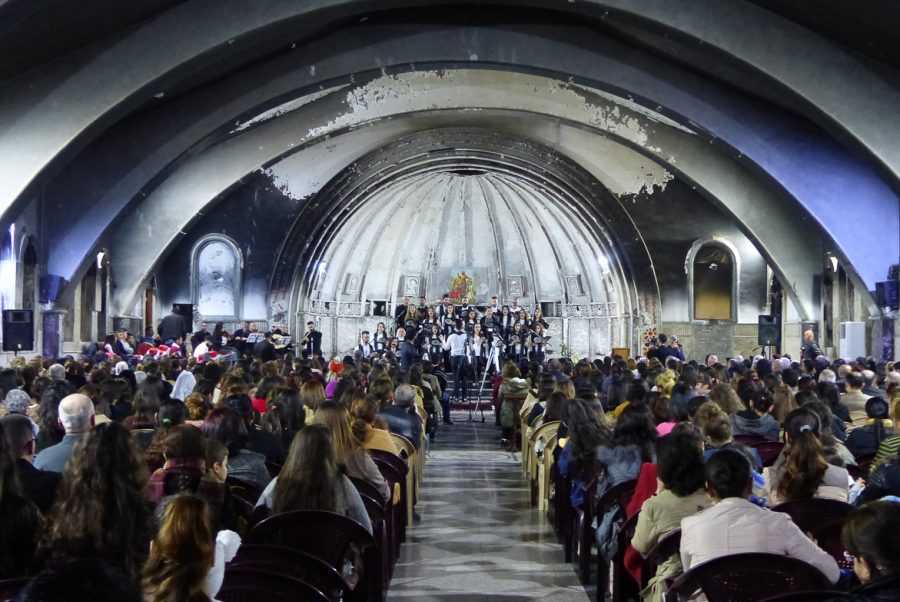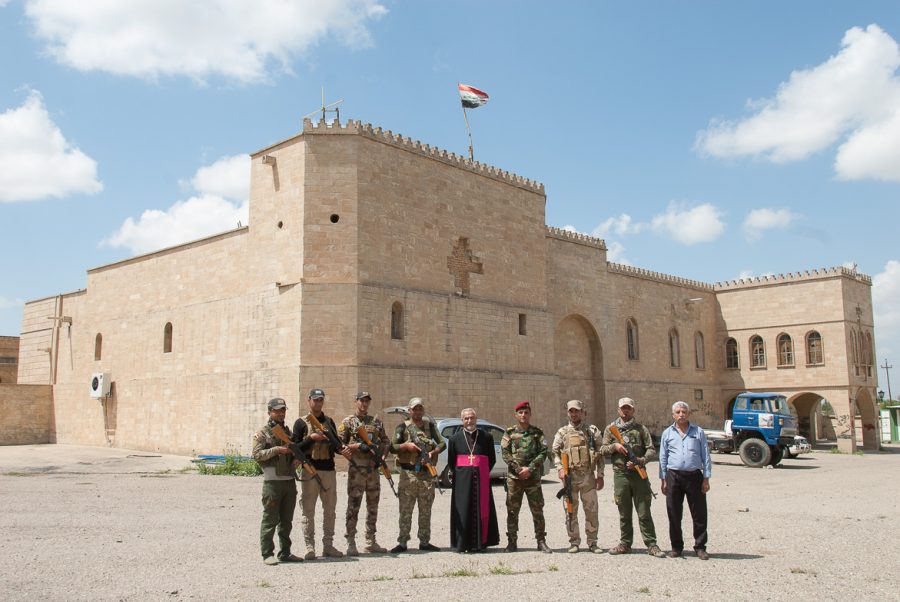Mart Shmoni Church in Baghdede (Qaraqosh)
The Syriac-Orthodox Mart Shmoni church in Baghdede (Qaraqosh) lies 36°15’58.44″N 43°22’31.17″E and 273 metres high.
Mart Shmoni church in Baghdede has been burnt out by ISIS.
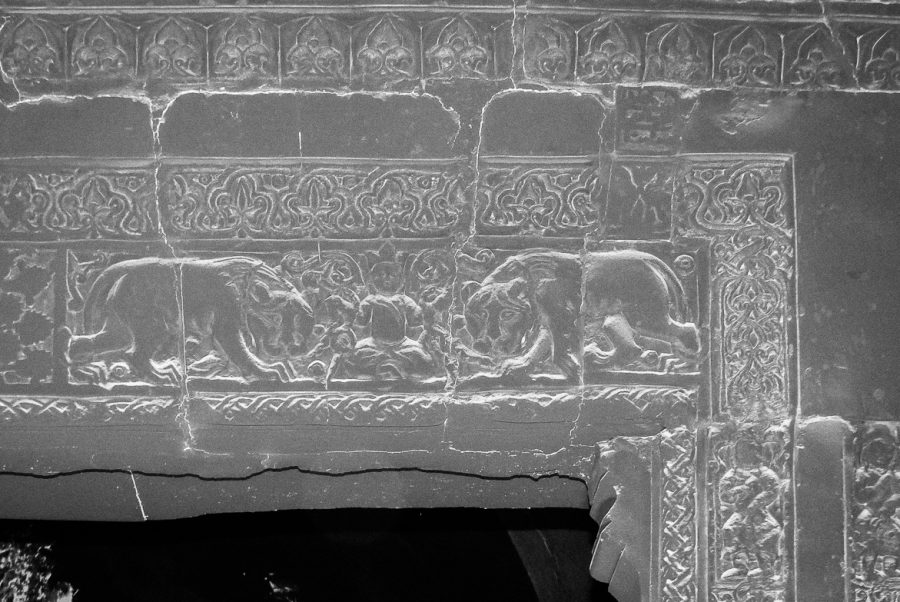
The lintel and doorframe of the royal gate in the church of Mart Shmoni are thinly carved with 12th century bas-reliefs, featuring among others Mart Shmoni’s (Saint Simone’s) children, the Maccabees.
These figurines have been carved with Mongol-looking faces and clothes, and this reveals that Christian art in Mesopotamia in the 12thcentury received some political and cultural influence from different sources. In a bas-relief, a man, sitting cross-legged with eyes closed and holding on either side two lions on a lead features “Daniel with the lions”, and is a typical representation of the wisdom that man aims at.
Plan of Mart Shmoni church in Baghdede before renovation.
Plan according to Suhayll Qash, modified, 1982, extract from « Les églises et monastères du Kurdistan irakien à la veille et au lendemain de l’islam », PhD thesis by Narmen Ali Amen. Saint Quentin en Yvelines University. May 2001, p.192
Location
The Syriac-Orthodox Mart Shmoni church lies 36°15’58.44″N 43°22’31.17″E and 273 metres high, southwest of Baghdede, on an archaeological tell (hill), only 500 metres away from another Syriac-Orthodox church of Mar Sarkis and Bakus. 50 years ago, Mart Shmoni church was on the outskirts of the town, and was surrounded by fields and orchards.
At the very heart of the Syriacs’ plain, Baghdede (Qaraqosh) lies 30 km southeast from Mosul and 80 km west from Erbil and is the largest Christian town of the Nineveh plain. It also lies 40 km upstream from the confluence between the Tigris River and the Great Zab. Some sort of community and religious “capital city”, in a sense.
Baghdede toponymy
The name Qaraqosh, which in modern Turkish means Black Bird, is quite frequently used but its other and original name, Baghdede (Baghdeda) in Syriac language “probably comes from Bet Khudaydad which combines both semitic (Bet) and Persian (Khudaydad) origins [and which]means the place, the house given by God”[1]. This Syriac name must not be ignored as it seems to be the most in use nowadays.
[1]Source Jean-Marie Mérigoux, O.P., in « L’Orient chrétien dans l’empire musulman », Collection Studia Arabica III, Editions de Paris, 2005.
Fragments of the Christian history of Baghdede
According to the tradition, Christianity entered the Nineveh plain and the city of Baghdede at the end of the 4thcentury or the beginning of the 5thcentury. More than likely, sources argue that evangelisation began in the 7thcentury. “The village was first Nestorian[1], then around 615 [it] became Monophysite[2]. In the 11thand 12thcentury, many Christians from Tikrit, before being forced to convert to Islam, left Tikrit and settled in Baghdede. In 1743, Nader Shah’s troops besieged the area, plundered Baghdede and destroyed the churches.
At that time, the villagers escaped to Mosul and took part in the defence of the town”[3]. Former Syriac-Orthodox see of the archbishopric, it is by the end of 18thcentury that the village became Catholic.
There are still several ancient Syriac-Catholic and Orthodox churches in nowadays Baghdede. All have been violated, sullied, plundered, even burnt by ISIS, all along the 26 months it occupied the city, from August 2014 to October 2016. Despite wreckages and destructions, some of these churches still stand firm against time and invaders and carry on being testament to this distant past.
Since the town was liberated in October 2016 and the returning of many inhabitants from April 2017 on, Baghdede is considered as an essential geographic pole for the Christian and Syriac revival in the Nineveh plain and throughout Mesopotamia.
[3]Source Jean-Marie Mérigoux, O.P., in « L’Orient chrétien dans l’empire musulman », Collection Studia Arabica III, Editions de Paris, 2005.
Demography in Baghdede
It would be much risky to present some reliable statistics regarding the demography of this town (and of the whole country), as census is made impossible by successive wars and never-ending mass movements of population. Nevertheless, we can admit that at least 40 000 to 50 000 people used to live in Baghdede before ISIS attacked. Some probably overestimated statements, made by natives, mention about 70 000 inhabitants.
To these must be added thousands of displaced population (5 000 to 13 000 depending on the different phases), Christian people from Baghdad or Mosul who had settled in Baghdede from 2003 on, all running away from crimes and misdemeanours committed by terrorist or mafia groups that appeared after the Iraqi state collapsed and for whom great efforts had been provided with the aim of a long-lasting settlement.
Whatever the reality of demographical data, nearly 90 % of the inhabitants in Baghdede were Syriac-Catholics. The other 10 % were being split between Chaldeans (Catholic), Syriac-Orthodox, as well as a tiny apostolic Armenian community.
Before 1980, this city was said to be exclusively Christian. But afterwards, several tens of Muslim families progressively settled in, as part of the campaign of Arabisation of the Nineveh plain set up by Saddam Hussein.
Fragments of a hagiography
The hagiography of Mart Shmoni and her seven saint children is very well known throughout all the Christian East in Mesopotamia. The story of this Jewish family is related in chapter 7, from the second Book of the Maccabees. It reveals how the Jewish were persecuted under the reign of the Seleucid king Antiochus IV Epiphanes, because they respected the Laws of God and and already believed in resurrection and eternal life… two centuries before the advent of Christianity.
The seven Maccabees brothers were then “arrested with their mother and forced to eat pork[1]” in order to abjure their faith. All refused and were sentenced to death and killed, one after the other, under their mother’s eyes. The first one was then “horribly tortured, then fried alive in a pan[2](…)”. Despite her great distress, their mother, Mart Shmoni, encouraged them, one after the other, to remain faithful to the Law of God, until the very last, begging him not to fear the torturer and to “be up to your brothers, accept your death, so that I can come and join you all in mercy.”[3]
[1]In La Bible rendue à l’histoire, Jean Potin, éditions Le Club, Juin 2000, p.616
History of Mart Shmoni church in Baghdede
The date of the construction of the Syriac-Orthodox Mart Shmoni church in Baghdede is unknown. The style of the inscriptions running along the doorframe of the royal door leading to the sanctuary would suggest it dates back to the 12thcentury[1], thus without certainty as the building could possibly date from the 18thcentury[2]. Some historical sources can be read in some manuscripts. Henceforth, “a manuscript has been copied in 1728, in the church of Mart Šmūni her seven sons and their master Eleazar[3]”.This historical (though coming a bit late) confirmation asserts that Mart Shmoni goes back to the first third of the 18thcentury.
[1]In Assyrie Chrétienne, Jean-Maurice Fiey, Beyrouth, 1965, p.449-451
[2]« Les églises et monastères du Kurdistan irakien à la veille et au lendemain de l’islam », thèse de doctorat de Narmen Ali Amen. Université de Saint Quentin en Yvelines. Mai 2001, p.190-195 + planches CLXIV à CLXXIV.
[3]In Assyrie chrétienne, Jean-Maurice Fiey, Beyrouth, 1965, p.451
Description of Mart Shmoni church in Baghdede
All around the tell on which the Syriac-Orthodox Mart Shmoni church has been erected runs a 4-meter high surrounding wall.
After the surrounding wall’s gate, the area opens onto a long staircase, which used to be more rudimentary but is now lined with a stone banister, leading to the top of the hill on which the church stands[1]. At the top of the stairs, the northern door opens onto the church; it is a side door, as the church stands eastwards oriented.
The walls of Mart Shmoni church are covered with a white cut stone facing and here and there with some Mosul grey marble facing. A high-relief representing the martyrdom of Mart Shmoni and of her seven children figures prominently on the church’s northern façade.
Inside the church, what strikes most is the blackness of the place. Early 2018, facing the entrance door, slightly on the right (the chancel being on the left), we could still observe ashes remaining from two big fires set up by ISIS, burning a pile of some of the church’s benches. At this date, a backup light was still necessary to walk around in this sullied church, all blackened with soot.
The church has a basilica-shaped architecture, with a central nave and two side-aisles. Just like for the church of Saints Sarkis and Bakus, the chevet, – standing slightly above the floor thanks to one step, consists in a protruding apse topped by a finely crafted cupola. There again, the building is typical of western Assyrian, Syriac-Orthodox and Catholic churches. The Holy of Holies (the sanctuary), eastwards oriented, is made of three parts. In the centre, against the apse’s wall, stands the high altar. It has open accesses to either side to the side rooms: the martyrion (bēt sōhdē, in Syriac language) on the north, and the sacristy (bēt diāqōn) on the south.
The lintel and the doorframe of the royal door of the church of Mart Shmoni are thinly carved with 12th-century bas-reliefs, featuring among others Mart Shmoni’s children, the Maccabees.
This frieze has fortunately not been hammered but « only » darkened by the smoke. These figurines have been carved with Mongol-looking faces and clothes, and this reveals that Christian art in Mesopotamia in the 12thcentury received political and cultural influence from different sources. In a bas-relief, a man sits cross-legged with eyes closed and holding on either side two lions on a lead features “Daniel with the lions”; it is a typical representation of the wisdom that man aims at.
On the door lintel, an inscription reports that the church has been restored (12thcentury?). The royal door is also adorned with carved niches, right and left from glorious crosses.
After the royal door, stands the stone high-altar with steps, under a dome which is only lit by a feeble light. And here again, the ground is littered, still in January 2018, by the ashes of some other arson.
The inside walls of Mart Shmoni church reveal some stone or marble plates, carved with inscriptions or adorned with Syriac crosses.
Left from the high altar, a low door with a flower-patterned carved border gives access to the northern side-aisle.
The Syriac-Orthodox church of Mart Shmoni has obviously been restored and modernised at the end of the 20thcentury. During the 80’s, the church still had a narthex that has been destroyed to allow the building to be extended. The inhabitants still relate today, that in the 80’s, the Mosul archaeological office had demanded that no restoration was made to this very ancient building to extend it. The inhabitants have obviously carried on regardless to this decision and have worked at night at “modernising” the church.
Since those times, the western façade has been surmounted by an elegant crafted bell tower.
[1]Observations effectuées par Pauline Bouchayer (Mesopotamia) en décembre 2017 et Janvier 2018.
News from Mart Schmoni church in Baghdede
The church of Mart Shmoni in Baghdede has been sacked and burnt by ISIS.
Left as is, during our last visit in January 2018, “no celebration seems to have taken place in this church since the Christians returned to Baghdede[1].” No Syriac-Orthodox priest has (yet) returned for this denominational community and its three churches. “Less than 150 Syriac-Orthodox families are supposed to have returned[2] ” to Baghdede.
[1]Observations faites par Pauline Bouchayer (Mesopotamia) fin décembre 2017.
Monument's gallery
Monuments
Nearby
Help us preserve the monuments' memory
Family pictures, videos, records, share your documents to make the site live!
I contribute
